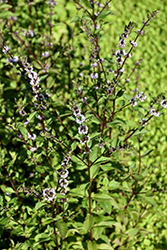Fri & Sat 8am - 8pm
Sun 8am - 7pm
Anytown, USA 12345
fax: 261.787.0463
e-mail: info@successgc.com


Plant Finder

Height: 24 inches
Spread: 3 feet
Sunlight:
![]()
![]()
Hardiness Zone: 6b
Other Names: Australian Mint
Description:
This mint variety grows fast, quickly colonizing an area and should have some form of root barrier; used in culinary recipes or steeped as a tea; whorls of pretty white flowers rise above bright green foliage on dark burgundy stems in summer
Edible Qualities
River Mint is a perennial herb that is typically grown for its edible qualities, although it does have ornamental merits as well. The fragrant oval light green leaves are usually harvested from late spring to early fall. The leaves have a minty taste.
The leaves are most often used in the following ways:
- Fresh Eating
- Cooking
- Seasoning
- Tea
Features & Attributes
River Mint features airy spikes of white star-shaped flowers rising above the foliage from early to late summer. Its attractive fragrant oval leaves remain light green in color throughout the season. The burgundy stems are very colorful and add to the overall interest of the plant.
This is an herbaceous perennial herb with a spreading, ground-hugging habit of growth. Its relatively fine texture sets it apart from other garden plants with less refined foliage. This is a high maintenance plant that will require regular care and upkeep, and should be cut back in late fall in preparation for winter. It is a good choice for attracting bees and butterflies to your yard, but is not particularly attractive to deer who tend to leave it alone in favor of tastier treats. Gardeners should be aware of the following characteristic(s) that may warrant special consideration;
- Invasive
Aside from its primary use as an edible, River Mint is sutiable for the following landscape applications;
- Mass Planting
- General Garden Use
- Groundcover
- Herb Gardens
- Container Planting
Planting & Growing
River Mint will grow to be about 24 inches tall at maturity, with a spread of 3 feet. Its foliage tends to remain dense right to the ground, not requiring facer plants in front. It grows at a fast rate, and under ideal conditions can be expected to live for approximately 10 years. As an herbaceous perennial, this plant will usually die back to the crown each winter, and will regrow from the base each spring. Be careful not to disturb the crown in late winter when it may not be readily seen!
This plant is quite ornamental as well as edible, and is as much at home in a landscape or flower garden as it is in a designated herb garden. It does best in full sun to partial shade. It is quite adaptable, prefering to grow in average to wet conditions, and will even tolerate some standing water. It is not particular as to soil pH, but grows best in clay soils. It is highly tolerant of urban pollution and will even thrive in inner city environments. This species is not originally from North America. It can be propagated by division.
River Mint is a good choice for the edible garden, but it is also well-suited for use in outdoor pots and containers. Because of its spreading habit of growth, it is ideally suited for use as a 'spiller' in the 'spiller-thriller-filler' container combination; plant it near the edges where it can spill gracefully over the pot. It is even sizeable enough that it can be grown alone in a suitable container. Note that when growing plants in outdoor containers and baskets, they may require more frequent waterings than they would in the yard or garden.
